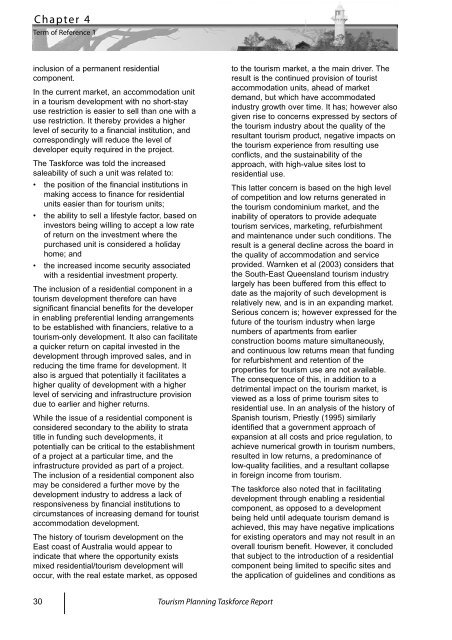Tourism Planning Taskforce Report - Western Australian Planning ...
Tourism Planning Taskforce Report - Western Australian Planning ...
Tourism Planning Taskforce Report - Western Australian Planning ...
- No tags were found...
Create successful ePaper yourself
Turn your PDF publications into a flip-book with our unique Google optimized e-Paper software.
Chapter 4Term of Reference 1inclusion of a permanent residentialcomponent.In the current market, an accommodation unitin a tourism development with no short-stayuse restriction is easier to sell than one with ause restriction. It thereby provides a higherlevel of security to a financial institution, andcorrespondingly will reduce the level ofdeveloper equity required in the project.The <strong>Taskforce</strong> was told the increasedsaleability of such a unit was related to:• the position of the financial institutions inmaking access to finance for residentialunits easier than for tourism units;• the ability to sell a lifestyle factor, based oninvestors being willing to accept a low rateof return on the investment where thepurchased unit is considered a holidayhome; and• the increased income security associatedwith a residential investment property.The inclusion of a residential component in atourism development therefore can havesignificant financial benefits for the developerin enabling preferential lending arrangementsto be established with financiers, relative to atourism-only development. It also can facilitatea quicker return on capital invested in thedevelopment through improved sales, and inreducing the time frame for development. Italso is argued that potentially it facilitates ahigher quality of development with a higherlevel of servicing and infrastructure provisiondue to earlier and higher returns.While the issue of a residential component isconsidered secondary to the ability to stratatitle in funding such developments, itpotentially can be critical to the establishmentof a project at a particular time, and theinfrastructure provided as part of a project.The inclusion of a residential component alsomay be considered a further move by thedevelopment industry to address a lack ofresponsiveness by financial institutions tocircumstances of increasing demand for touristaccommodation development.The history of tourism development on theEast coast of Australia would appear toindicate that where the opportunity existsmixed residential/tourism development willoccur, with the real estate market, as opposedto the tourism market, a the main driver. Theresult is the continued provision of touristaccommodation units, ahead of marketdemand, but which have accommodatedindustry growth over time. It has; however alsogiven rise to concerns expressed by sectors ofthe tourism industry about the quality of theresultant tourism product, negative impacts onthe tourism experience from resulting useconflicts, and the sustainability of theapproach, with high-value sites lost toresidential use.This latter concern is based on the high levelof competition and low returns generated inthe tourism condominium market, and theinability of operators to provide adequatetourism services, marketing, refurbishmentand maintenance under such conditions. Theresult is a general decline across the board inthe quality of accommodation and serviceprovided. Warnken et al (2003) considers thatthe South-East Queensland tourism industrylargely has been buffered from this effect todate as the majority of such development isrelatively new, and is in an expanding market.Serious concern is; however expressed for thefuture of the tourism industry when largenumbers of apartments from earlierconstruction booms mature simultaneously,and continuous low returns mean that fundingfor refurbishment and retention of theproperties for tourism use are not available.The consequence of this, in addition to adetrimental impact on the tourism market, isviewed as a loss of prime tourism sites toresidential use. In an analysis of the history ofSpanish tourism, Priestly (1995) similarlyidentified that a government approach ofexpansion at all costs and price regulation, toachieve numerical growth in tourism numbers,resulted in low returns, a predominance oflow-quality facilities, and a resultant collapsein foreign income from tourism.The taskforce also noted that in facilitatingdevelopment through enabling a residentialcomponent, as opposed to a developmentbeing held until adequate tourism demand isachieved, this may have negative implicationsfor existing operators and may not result in anoverall tourism benefit. However, it concludedthat subject to the introduction of a residentialcomponent being limited to specific sites andthe application of guidelines and conditions as30 <strong>Tourism</strong> <strong>Planning</strong> <strong>Taskforce</strong> <strong>Report</strong>

















